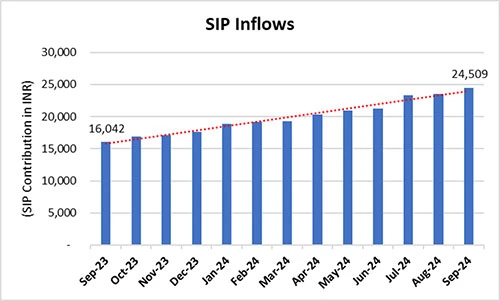With 2025 on the horizon, SIPs (Systematic Investment Plans) have become more than just a tool for disciplined investing they are a way to capitalize on market opportunities in an uncertain economic climate. The volatile global market environment, fueled by inflationary pressures, geopolitical uncertainties, and shifting economic policies, underscores the importance of consistent investing rather than timing the market.
SIPs allow investors to invest steadily and benefit from rupee cost averaging, which can lower the impact of market fluctuations by spreading investments over time.
The global financial landscape has faced heightened volatility due to factors such as inflationary pressures, geopolitical instability, and varying economic policies. In this environment, SIPs stand out as a prudent investment strategy, enabling investors to navigate market fluctuations by spreading investments across time, reducing the need to time the market perfectly.
[Read: How the SIP Calculator Can Help Investors Achieve Financial Goals]
Indian Mutual Funds have currently about 9.87 crore (98.7 million) SIP accounts through which investors regularly invest in Indian Mutual Fund schemes. In recent years, investor traction towards SIPs has been on a steady rise, with the Association of Mutual Funds in India (AMFI) reporting record-breaking SIP inflows.
In 2024, SIP inflows have consistently exceeded Rs 15,000 crore per month, a significant increase compared to previous years. In September 2024, SIP inflows were Rs 24,509 crores and the number of new SIP accounts registered are 66.39 lakhs. AMFI data shows a growing commitment to SIPs as investors continue to allocate a portion of their savings to this investment avenue.
Graph: SIP Inflows/Contribution on Year-to-Date (YTD) basis
Data as of September 30, 2024
(Source: AMFI, data collated by PersonalFN Research)
The ease of opening SIPs online through apps and investment platforms has made investing more accessible. Investors can now start and manage SIPs from their smartphones, making it easier for people across all demographics to participate in the market.
While it’s common to look for ‘Best SIP plans’ or ‘Top performing SIP plans’ the truth is that SIPs are just investment strategies, not specific products. SIP is a way to invest systematically in a mutual fund over time, which can help average out market volatility. Therefore, what’s truly important is the mutual fund scheme that you choose to invest in via SIP, as this will directly impact your potential returns and risk exposure.
[Read: Best Mutual Funds to Invest Now]
Selecting the right mutual fund scheme for a SIP is crucial to building a successful investment portfolio that aligns with your financial goals, risk tolerance, and time horizon. With numerous schemes available, choosing the one that fits best can seem challenging. Here’s a guide to help you select the right mutual fund scheme for SIP.
Building Your Corpus with a Monthly SIP of Rs 10,000
Let’s consider a monthly SIP of Rs 10,000 in some of the top-performing mutual funds across some of the popular sub-categories and calculate the potential corpus built over five years, along with the Extended Internal Rate of Return (XIRR) for each. Assuming annualized returns based on past data, we’ll see how each category fares over five years.
| Investment Duration | Total Invested Amount (in INR) | Estimated Corpus at 12% XIRR (Amount in INR) |
| 1 year | 1,20,000 | 1,26,800 |
| 3 years | 3,60,000 | 4,40,100 |
| 5 years | 6,00,000 | 8,16,000 |
| 10 years | 12,00,000 | 23,23,800 |
| 15 years | 18,00,000 | 50,91,100 |
| 20 years | 24,00,000 | 1,04,93,000 |
This table is just for illustration purposes only.
While past performance doesn’t guarantee future results, it gives insight into how the fund has managed different market cycles.
[Read: How to Use XIRR While Calculating SIP Returns]
Best SIP Plan #1 – Quant Small Cap Fund
Quant Small Cap Fund focuses on investing in small-cap companies, typically those ranked beyond the top 250 stocks on Indian exchanges by market capitalization. Launched in October 1996, this momentum-driven fund in the small-cap category has delivered remarkable performance in recent years, consistently ranking at the top of its category across various timeframes.
Over the last five years, Quant Small Cap Fund grew at an XIRR of 45.86% compared to 35.13% XIRR in its benchmark Nifty Smallcap 250 – TRI.
Performance of Quant Small Cap Fund
| Scheme Name | Total Amount Invested (Rs) | Present Value (Rs) | XIRR (%) | Benchmark | XIRR (%) |
| Quant Small Cap Fund | 6,00,000 | 18,09,435 | 45.86 | Nifty Smallcap 250 – TRI | 35.13 |
Data as of October 05, 2024
Past performance is not an indicator of future returns.
The securities quoted are for illustration only and are not recommendatory
(Source: ACE MF, data collated by PersonalFN)
Being a small-cap fund, it comes with higher risk due to the volatility associated with smaller companies. Small caps can generate substantial returns during market upswings, but they can also suffer sharp declines in downturns.
For 2025, adding a small-cap fund to a diversified SIP portfolio may complement other fund categories like large-cap and hybrid funds, but it should be done keeping risk and goals in perspective.
[Read: Best SIP Mutual Funds with High Returns: Quant Large & Mid Cap Fund vs Bandhan Core Equity Fund]
Best SIP Plan #2 – Motilal Oswal Mid Cap Fund
Motilal Oswal Midcap Fund is a popular mutual fund within the mid-cap category, focusing on companies with a market capitalization falling in the mid-cap range. This fund is often sought by investors looking to capture growth opportunities from mid-sized companies that may have higher growth potential than large-cap stocks but are less risky compared to small-cap companies.
Launched in February 2014, Motilal Oswal Mid Cap Fund is a growth-oriented scheme that follows an active investment style invest. Historically, the fund has at times surpassed both its benchmark and category average across different market cycles, establishing itself as a top performer within the category over long-term periods.
Over the last five years, Motilal Oswal Mid Cap Fund grew at an XIRR of 40.44% compared to 31.46% XIRR in its benchmark Nifty Smallcap 250 – TRI.
Performance of Motilal Oswal Midcap Fund
| Scheme Name | Total Amount Invested (Rs) | Present Value (Rs) | XIRR (%) | Benchmark | XIRR (%) |
| Motilal Oswal Midcap Fund | 6,00,000 | 15,99,958 | 40.44 | Nifty Midcap 150 – TRI | 31.46 |
Data as of October 05, 2024
Past performance is not an indicator of future returns.
The securities quoted are for illustration only and are not recommendatory
(Source: ACE MF, data collated by PersonalFN)
Given its mid-cap focus, it tends to be more volatile but can offer attractive long-term returns, especially when invested through a Systematic Investment Plan (SIP) that allows for rupee-cost averaging.
Motilal Oswal Midcap Fund could be an attractive option for investors seeking a balanced risk-reward profile in the mid-cap space. SIP in this fund, backed by disciplined investing and patience, can potentially yield impressive results over the long term.
Best SIP Plan #3 – Quant Flexi Cap Fund
Quant Flexi Cap Fund is an actively managed equity mutual fund that invests across market capitalizations-large-cap, mid-cap, and small-cap-offering flexibility to adjust its allocation based on market conditions and investment opportunities. This strategy allows it to capture growth potential across various market segments while managing risk through diversification.
Launched in September 2008, Quant Flexi Cap Fund has demonstrated strong historical returns, often outperforming the benchmark index and peer funds in the flexi-cap category. However, due to its dynamic nature, it may experience higher volatility.
[Read: Highest Return Mutual Funds in the Last 10 Years – Flexi Cap Fund Category]
Over the last five years, Quant Flexi Cap Fund grew at an XIRR of 33.31% compared to 22.49% XIRR in its benchmark Nifty 500 – TRI.
Performance of Quant Flexi Cap Fund
| Scheme Name | Total Amount Invested (Rs) | Present Value (Rs) | XIRR (%) | Benchmark | XIRR (%) |
| Quant Flexi Cap Fund | 6,00,000 | 13,56,089 | 33.31 | NIFTY 500 – TRI | 22.49 |
Data as of October 05, 2024
Past performance is not an indicator of future returns.
The securities quoted are for illustration only and are not recommendatory
(Source: ACE MF, data collated by PersonalFN)
Quant Mutual Fund’s unique investment philosophy, which incorporates macroeconomic analysis and a quant-based approach, often appeals to investors looking for tactical opportunities in the equity space.
Quant Flexi Cap Fund could be an attractive option for investors looking for flexible, high-growth potential in their SIP portfolios. However, it’s essential to monitor its performance periodically, as flexi-cap funds are highly responsive to market conditions.
Best SIP Plan #4 – Nippon India Large Cap Fund
As one of the prominent offerings from Nippon India Mutual Fund (formerly known as Reliance Mutual Fund), it aims to provide long-term capital appreciation by investing in companies with a proven track record and strong market capitalization. The fund focuses on high-quality stocks that have the potential for sustainable growth and stability.
Launched in August 2007, Nippon India Large Cap Fund targets strong businesses trading at attractive valuations to minimize risks and generate alpha. It emphasizes companies that are current or emerging leaders, possessing robust business models, sustainable cash flows, and high or potentially high returns on equity (RoE).
[Read: 5 Top-performing Large Cap Mutual Funds of 2024]
Over the last five years, Nippon India Large Cap Fund achieved an XIRR of 26.11%, compared to 22.49% for its benchmark, the Nifty 500 – TRI.
Performance of Nippon India Large Cap Fund
| Scheme Name | Total Amount Invested (Rs) | Present Value (Rs) | XIRR (%) | Benchmark | XIRR (%) |
| Nippon India Large Cap Fund | 6,00,000 | 11,43,670 | 26.11 | NIFTY 500 – TRI | 22.49 |
Data as of October 05, 2024
Past performance is not an indicator of future returns.
The securities quoted are for illustration only and are not recommendatory
(Source: ACE MF, data collated by PersonalFN)
The fund’s top stock holdings include index heavyweights such as HDFC Bank, ICICI Bank, Reliance Industries, ITC, and Infosys. Its sectoral exposure is inclined towards Banking & Finance, followed by Infotech, Consumption, Petroleum, and Power, among others.
The Nippon India Large & Mid Cap Fund is ideal for investors looking to invest in equities for a minimum of 5-7 years and willing to accept higher risk for potentially higher returns. It is a good fit for those who want a blend of stability and growth within the equity mutual fund space.
Best SIP Plan #5 – Motilal Oswal Large & Mid Cap Fund
Motilal Oswal Large & Mid Cap Fund is an open-ended equity mutual fund that primarily invests in large-cap and mid-cap stocks. Launched in October 2019, the fund predominantly invests approximately 70-80% in large-cap stocks and 20-30% in mid-cap stocks. This allocation is designed to leverage the stability of large-cap companies while tapping into the growth potential of mid-cap firms.
The fund follows a bottom-up investment strategy, emphasizing fundamental research to identify quality companies with robust growth potential, sound management, and strong financials. The fund is actively managed, allowing fund managers to make investment decisions based on market conditions and economic indicators.
Over the last five years, Nippon India Large Cap Fund achieved an XIRR of 33.61%, compared to 25.43% for its benchmark, the Nifty 500 – TRI.
Performance of Motilal Oswal Large & Mid Cap Fund
| Scheme Name | Total Amount Invested (Rs) | Present Value (Rs) | XIRR (%) | Benchmark | XIRR (%) |
| Motilal Oswal Large & Midcap Fund | 6,00,000 | 13,65,728 | 33.61 | NIFTY LargeMidcap 250 – TRI | 25.43 |
Data as of October 05, 2024
Past performance is not an indicator of future returns.
The securities quoted are for illustration only and are not recommendatory
(Source: ACE MF, data collated by PersonalFN)
The fund employs an active portfolio management strategy to effectively identify multibagger opportunities, primarily focusing on the large-cap and mid-cap segments. Its strong performance in recent years has significantly enhanced its long-term returns, positioning it among the top performers in its category across various timeframes.
As we approach 2025, the Motilal Oswal Large & Mid Cap Fund presents a compelling option for investors seeking growth through a balanced exposure to large and mid-cap equities. While the fund has demonstrated a strong historical performance, investors need to conduct thorough due diligence, considering their unique circumstances before committing to any investment.
To conclude…
As investors prepare for 2025, focusing on SIPs can offer a balanced, strategic approach that combines discipline, compounding, and risk management. The adaptability of SIPs also makes them a strong choice for individuals at various stages of their financial journeys.
For new investors, SIPs provide an entry point into the equity markets with manageable monthly contributions, allowing them to build wealth gradually. Experienced investors can use SIPs to complement their broader portfolios, adding a layer of stability and compounding power.
Choosing the right fund to invest in via SIPs can make all the difference, as it allows investors to harness the growth potential of sectors and companies that are poised to thrive in the coming years. Embracing SIPs in mutual funds for 2025 is not only a sound investment decision but a proactive step towards a financially empowered future.
This article first appeared on PersonalFN here




